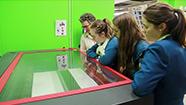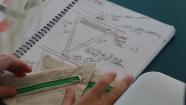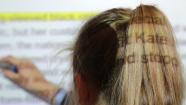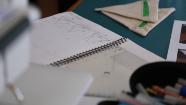A year 13 class connects with a fabric printing company to outsource their printing.
Outsourcing digital fabric printing
Transcript
Steve Richards: I’m Steve Richards and I am the owner of Digital Decor and this business started originally as being a business manufacturing hunting clothing, made in New Zealand. That became too difficult because, obviously, the imports from China. A few years ago we learnt about sublimation and so we decided that there was potential for us to print our own fabrics because the problem when you’re making camouflage fabric in particular, was that you have to buy such large volumes of it. So we were having to buy three thousand metres of each pattern and colour. So we discovered this sublimation and then so we just worked towards that and when it became too difficult for us to compete in that market because of the Chinese-made stuff, we decided to change the business into Digital Decor, which is just us totally printing decor fabrics.
Basically sublimation is when something goes from a solid to a gas. So what we do is print onto transfer paper, and then once that’s heated, it turns into gas and then it actually goes into a molecular level into the fabric. So the molecules of colour actually connect to the molecules of polyester fibre. Synthetic fibres work because synthetic fibres have more of the molecules for the colours to connect to. Natural fibres are very difficult to print because there are so many steps in the process to achieve the final print. Synthetic fibres are much easier to print. When we print, we print it on a transfer paper, bring that transfer paper down here, put it on a bit of fabric, put it on the heat press, BANG it’s on there. It’s perfect and it’s permanent, you know, the job’s finished.
We do a wide range of things from street flags, flags, that sort of thing. We do apparel, so we do sports apparel, we also do a lot with the universities, the polytechs, Otago, Massey, and also up in the Bay of Plenty. We also do sublimation for the schools and things like that, where they might have a project and they might want to do togs or whatever projects. We were approached by Julie, from Wellington Girls’ College, and they obviously had a project at hand. They work with one of my workers here, Celia, so we ended up printing the prints for them and then transferring them.
Julie Clement: So in year 13 I was looking for a new project for the girls, and thinking about teenagers and knowing that they love swimwear, we have a new digital mermaids brief. So the girls research how swimwear design has changed over time to the whole use of, like, wool fibres right through to lycra. I also have a passion for photoshop and printing. I thought about how could the girls print their own fabric. I knew through my study at Massey that Digital Decor were out here, so I made contact with Steve, and it was all go. So the girls designed their own prints, in Photoshop, they send their designs out here, we get them tested, and then printed into the final design for swimwear. We’re really fortunate too, to have the Gerber printer, so pattern making is the girls' second passion. So we used that system to design bikinis or swimwear. The girls are inspired by a trip to Sydney and we go to SeaFolly.
Steve Richards: We like working with students from college right through to tertiary education and because we see that as being the future customers of this business. Because we can get them here, we can teach them how to do it or show them how to do it, and they know the limitations, they know the capabilities, and they go out into the market place and it gives us a lot of opportunities when they are out there. So if any schools are interested at all or want to get into it and do a project or anything like that, just contact us here and we’d be more than happy to help you.
Related videos
Fab Lab and Wellington Girls' College (04:14)
Wellington Girls' College connects with Fab Lab at Massey University.
Developing an initial brief for an organiser (01.27)
A year 8 student describes how she went about creating an initial brief for her organiser.
Examples for exploring brief development (00:58)
Two year 8 students describe their ideas about the types of specifications that would have been given for two famous outcomes....
Will my design for an organiser work? (02:02)
Two year 8 students describe their functional modelling of their designs for organisers.




